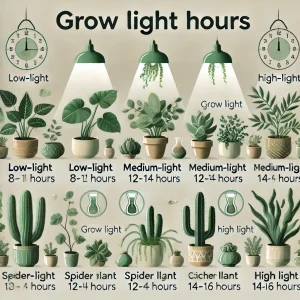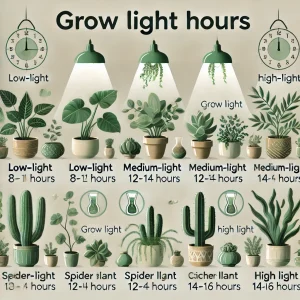Indoor gardening has gained immense popularity, allowing plant lovers to cultivate their favorite greens regardless of external weather conditions. A crucial factor in maintaining healthy indoor plants is providing adequate lighting, especially when natural sunlight is insufficient.
Grow lights serve as artificial light sources that promote plant growth by mimicking natural sunlight. However, the effectiveness of grow lights largely depends on the duration they are left on.
Understanding the appropriate lighting duration for different plant types ensures optimal growth, preventing issues such as leggy stems, leaf discoloration, and stunted growth.
This guide explores how many hours grow lights should be on for indoor plants, helping gardeners create the perfect lighting schedule for their plants.
How Many Hours Should Grow Lights Be On For Indoor Plants?
1. Photosynthesis and Light Exposure
Plants rely on light for photosynthesis, a process where they convert light energy into food. Different plant species have unique light requirements based on their natural habitat. Understanding how much light a plant needs is crucial to determining the appropriate grow light schedule.
2. Categories of Plants Based on Light Needs
Indoor plants can be grouped based on their light requirements:
- Low-Light Plants: These plants thrive in minimal light conditions (e.g., ferns, snake plants, pothos).
- Medium-Light Plants: Require moderate light for healthy growth (e.g., peace lilies, philodendrons).
- High-Light Plants: Need intense, prolonged exposure to light (e.g., succulents, cacti, herbs).
Knowing the category your plant falls into helps set the correct grow light duration to avoid underexposure or overexposure.
Recommended Grow Light Durations for Different Plants
1. Low-Light Indoor Plants
- Recommended Hours: 8 to 12 hours per day
2. Medium-Light Indoor Plants
- Recommended Hours: 12 to 14 hours per day
Understanding Medium-Light Plants and Grow Light Recommendations
Medium-light indoor plants thrive in environments with moderate light exposure, such as near windows with filtered sunlight or under artificial grow lights. They require more light than low-light plants but are not as demanding as high-light species. Examples include philodendrons, spider plants, calatheas, and ferns.
Recommended Grow Light Duration: 12 to 14 Hours Per Day
These plants need 12 to 14 hours of artificial light daily to sustain healthy growth. Insufficient light can lead to:
- Slow growth or stunted development.
- Pale, yellowing, or weak leaves due to inadequate photosynthesis.
- Leggy stems as the plant stretches toward the light source.
Why Full-Spectrum LED Grow Lights?
Full-spectrum LED grow lights mimic natural daylight, providing the essential wavelengths needed for photosynthesis and plant health. They ensure:
- Balanced blue and red light for optimal leaf and root development.
- Energy efficiency while preventing heat damage.
- Improved growth rates by closely resembling natural sunlight conditions.
Best Practices for Grow Light Use
- Position grow lights 12–24 inches above the plant to prevent excessive heat exposure.
- Use timers to maintain a consistent 12–14 hour light cycle.
- Rotate the plant occasionally for even light distribution and balanced growth.
By following these recommendations, medium-light plants can flourish indoors with artificial lighting that closely mimics their natural environment.
3. High-Light Indoor Plants
- Recommended Hours: 14 to 16 hours per day
Understanding High-Light Plants and Grow Light Recommendations
High-light indoor plants originate from sunny environments, such as deserts or open fields, where they receive intense, direct sunlight for most of the day. They require extended light exposure to support their growth and maintain their vibrant foliage. Examples include succulents, cacti, fiddle leaf figs, and hibiscus plants.
Recommended Grow Light Duration: 14 to 16 Hours Per Day
To thrive indoors, these plants need 14 to 16 hours of artificial light daily. Insufficient light can result in:
- Slow or stunted growth due to inadequate photosynthesis.
- Weak, leggy stems as the plant stretches toward light sources.
- Dull or faded leaves, reducing the plant’s overall health and aesthetics.
Why Grow Light Positioning Matters
Since these plants naturally receive high-intensity sunlight, placing grow lights closer helps replicate their natural conditions. The right placement ensures:
- Maximum light absorption, preventing weak growth.
- Even light distribution, reducing the risk of uneven growth patterns.
- Stronger stems and healthier foliage by promoting proper energy intake.
Best Practices for Grow Light Use
- Keep grow lights 6–12 inches above the plant to provide adequate brightness.
- Use a timer to maintain a consistent 14–16 hour light cycle.
- Adjust light intensity based on plant response—too much heat can cause leaf burn.
By following these guidelines, high-light indoor plants can receive the optimal light exposure they need to thrive indoors
Factors Influencing Grow Light Duration
1. Plant Growth Stage
- Seedlings: Require 16 to 18 hours of light daily for rapid growth.
- Vegetative Stage: Plants need 14 to 16 hours of light to develop strong stems and foliage.
- Flowering Stage: Many flowering plants, like orchids, thrive with 12 to 14 hours of light.
2. Type of Grow Light Used
- LED Grow Lights: Energy-efficient and provide optimal light intensity.
- Fluorescent Lights: Suitable for seedlings and houseplants.
- Incandescent Bulbs: Less effective for plant growth due to excessive heat.
Common Mistakes in Using Grow Lights
- Leaving Lights on 24/7: Plants require a dark period for respiration and recovery. Continuous exposure can disrupt their growth cycle.
- Incorrect Light Distance: Placing lights too close may scorch plants, while placing them too far reduces effectiveness.
- Using the Wrong Light Spectrum: Ensure grow lights provide full-spectrum light for balanced growth.
How Many Hours Should Grow Lights Be On For Indoor Plants FAQs
1. Can I leave grow lights on for 24 hours?
No, plants need a dark period for proper growth and metabolism. Keeping lights on 24/7 can stress plants and hinder their development.
2. How do I know if my plant is getting too much light?
Signs include yellowing leaves, brown leaf tips, and dry soil. Adjust light duration or increase the distance between the light and the plant.
3. Do all indoor plants need grow lights?
Not necessarily. Some low-light plants can survive without artificial lights if they receive indirect natural sunlight.
4. Can I use regular LED bulbs instead of grow lights?
Regular LED bulbs lack the full spectrum required for plant growth. Specialized grow lights are recommended for best results.
5. How far should grow lights be from plants?
The ideal distance depends on the light type:
- LED lights: 12 to 24 inches above plants
- Fluorescent lights: 6 to 12 inches above plants
6. What is the best grow light schedule for vegetables?
Vegetables generally need 14 to 16 hours of light per day to support strong growth and fruit production.
7. Can grow lights replace sunlight completely?
While grow lights can supplement or replace natural light, plants often thrive best when they receive a mix of both.
Conclusion
Understanding the appropriate grow light duration for indoor plants is essential for their health and development. Different plants require varying light exposure, with low-light plants needing 8-12 hours and high-light plants requiring 14-16 hours daily.
Factors like plant type, growth stage, and light spectrum influence the effectiveness of artificial lighting. By following best practices and avoiding common mistakes, indoor gardeners can ensure their plants thrive.
If you’re passionate about indoor gardening, invest in high-quality grow lights and set up a well-structured lighting schedule today. Your plants will thank you for it
Recent Posts
Healthy compost plays a critical role in citrus tree growth by improving soil structure, nutrient retention, and root oxygen availability. Research from agricultural extension programs shows...
Citrus trees require a precise balance of nutrients to maintain healthy foliage, strong root systems, and consistent fruit production throughout the growing season. Improper fertilization is one of...